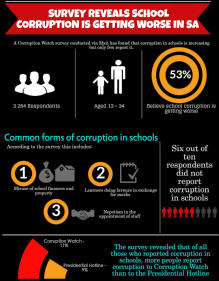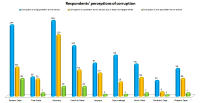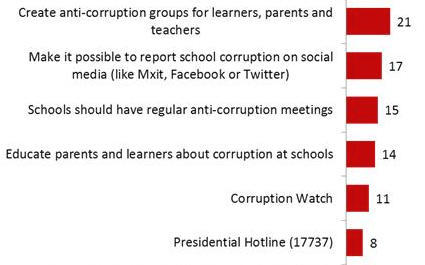|
Getting your Trinity Audio player ready...
|
 Since Corruption Watch launched its schools campaign, reports of irregularities in school management have been coming in thick and fast.
Since Corruption Watch launched its schools campaign, reports of irregularities in school management have been coming in thick and fast.
Since January 2012, the civil society organisation has received over 300 reports of corruption in schools via its website, SMS hotline, and telephone.
Corruption Watch has made schools monitoring a focus in 2013. Now, new data obtained from a survey held on popular communications platform Mxit in late August, has confirmed that the situation in schools needs urgent attention.
The survey, said Corruption Watch executive director David Lewis, was conducted by market research company Pondering Panda, and aimed to gain more insight into corruption in schools.
It polled 3 284 respondents between the ages of 13 and 34. This sample can be viewed as more comprehensive than a typical one from global watchdog Transparency International, which usually numbers around 2 000 respondents.
Almost half of the respondents were learners at school, or at a FET college, while 31% were family members of a school learner. Most learners (30%) were from public schools and only 8% were in private schools. There was an equal balance of male and female respondents.
The questions were targeted at the respondents’ perceptions of the level and types of corruption in schools, who they believe are the perpetrators of school corruption, and their usage of existing channels to report school corruption.
Schools corruption is not going away
The results showed that 53% of respondents believe that corruption in schools is generally getting worse but less than half of those aware of it, will report it – just 42% of respondents had submitted a complaint, the survey found. The provincial breakdown showed that at 70%, the Free State had the most non-reporters, followed by KwaZulu-Natal (67%) and the Western Cape (64%).
There were no major differences between corruption at public schools and corruption at private schools.
Besides the 53% who felt that corruption in schools is becoming a bigger problem, just 17% of respondents felt that corruption was getting better, while 13% believed that it was staying the same and 18% didn’t know. In provincial terms, respondents believed that 72% of schools in Mpumalanga were battling with a corruption problem, followed by Eastern Cape (60%) and North West (59%).
Those who reported corruption did so to a school principal or parent, or if a member of a school governing board (SGB), to an official anti-corruption institution such as the presidential hotline or the Education Department.
More people (11%) contacted Corruption Watch than the presidential hotline (9%). Males (13%) were more likely to report corruption to Corruption Watch, compared to females (7%). The age group more likely to turn to Corruption Watch was the 15-17-year-olds (13%), and 13- and 14-year-olds were more likely to report corruption to a parent or teacher, compared to other age groups.
Learners are the victims of corruption
Results showed that misuse of school money or property is the most common form of corruption in South African schools, followed by learners being told to do favours in exchange for marks, nepotism in staff appointments and procurement practices, and the sale of test and exam papers.
With year-end exams just around the corner, the survey identified favours for better marks and the selling of exam papers as the most common forms of bribery.
The survey found that the selling of test and exam papers was a particular problem in Mpumalanga (23%), while the misuse of school money or property was especially prevalent in the Free State (30%) and the North West provinces (31%).
The main person behind such corruption, according to 47% of all respondents, is the school principal, with 31% pointing a finger at teachers and 14% claiming that a member of the SGB is the culprit. The Eastern Cape was the province with the most corrupt principals (61%), the Free State (41%) had the worst teachers, and the Northern Cape (33%) the most corrupt SGB members.
Females were more likely than males to claim that a teacher was most responsible for the corruption (37% vs. 25%). Males were more likely to claim the principal was responsible (53% vs. 42%)
The majority of respondents (72%) believed that the principal was most responsible for the misuse of school money or property. And 48% felt the main culprit in nepotism was the principal, but a quarter of respondents said it was a member of the SGB.
In terms of soliciting favours from learners in exchange for better marks, 60% believed that teachers were most responsible for this, while 47% felt that teachers, mostly, were guilty of selling exam and test papers to learners.
What can be done about corruption?
While most respondents claimed they did not report corruption, they also identified ways in which corruption may be combatted. They also felt that regular anti-corruption meetings and anti-corruption groups were identified as the best way to fight corruption.
Social media was the second most popular suggestion, with respondents saying that they would like to use Mxit, Twitter or Facebook.
Only 14% felt that educating parents and learners about corruption would be effective. There were more people who felt that Corruption Watch (11%) is a better way of fighting corruption, than the presidential hotline (8%).
“This survey is just one of a series we plan to conduct into this matter so that we can a better picture of ways in which corruption manifest within schools. Mostly, we wish to encourage parents to get more involved in the running of their children’s schools and ensure that leaders in schools are held accountable,” said Lewis.
To allow for easy reporting of corruption in schools, Corruption Watch is piloting a 24-hour toll-free line. Members of the public who wish to report corruption in schools can call 0800 023 456.










